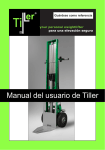Download Peer Instruction: A User`s Manual
Transcript
INSTRUCTIONS FOR USE The Conceptual Exam Questions in this file can be copied into your exams or modified to suit your needs. To locate a specific question: • Use the bookmarks at left • Click on the subject of the desired question. • Scroll down until you find the desired question. To search for a specific word or phrase within this file: • Use “Find” from the “Tools” menu . To copy or modify the text in this file: • Use “Select Text” from the “Tools” menu to copy the text you want use. • Paste the copied text into your word processor or other application. • Use “Select Graphics” from the “Tools” menu to copy the artwork. KINEMATICS 1. Two stones are released from rest at a certain height, one after the other. (a) Will the difference in their speeds increase, decrease, or stay the same? (b) Will their separation distance increase, decrease, or stay the same? (c) Will the time interval between the instants at which they hit the ground be smaller than, equal to, or larger than the time interval between the instants of their release? 2. As a space shuttle burns up its fuel after take-off, it gets lighter and lighter and its acceleration larger and larger. Between the moment it takes off and the time at which it has consumed nearly all of its fuel, is its average speed larger than, equal to, or smaller than half its final speed? 3. You are in an elevator that is rising at constant velocity. Suddenly you drop your keys; it so happens that when they strike the floor they are as high above ground level as when they left your hand. The keys fall dead on the floor without bouncing. Make a single graph showing qualitatively the height above ground of both the keys and the elevator as a function of time, starting from before the keys are released until after they strike the floor. 4. (a) Can astronauts floating in orbit tell which objects within their spaceship would be heavy or light on Earth even though everything in the ship is effectively weightless? Explain. (b) Could an astronaut use a “weightless” hammer in space to drive a nail through a piece of wood? Explain. 5. A battleship simultaneously fires two shells toward two enemy ships, one close by (A), one far away (B). The shells leave the battleship at different angles and travel along the parabolic trajectories indicated below. Which of the two enemy ships gets hit first? Explain. battleship A 6. B Cite an example of a body that accelerates while traveling at constant speed. Is it possible for a body to be accelerating while traveling at constant velocity? Explain. NEWTON’S LAWS 1. You are riding your bike along a flat country road. Indicate the direction and relative magnitude of the frictional forces on the front and rear tires in the following situations: (a) you are accelerating; (b) you are pedaling along at a steady pace; (c) you are braking. Both the brake and the pedals work on the rear wheel; there is no brake on the front wheel. 2. Identify all the action-reaction pairs that exist for a horse pulling a cart. Include Earth in your examination, but ignore air resistance. Make sure your notation makes clear which force acts on which object. 3. What is the smallest force with which you can raise an object on Earth into the air? 4. (a) A car is stationary on a flat parking lot.The force of gravity acts downward, and an equal and opposite normal force acts upward. State the law according to which these forces are equal and opposite. (b) When the car accelerates forward, which force is responsible for this acceleration? State clearly which body exerts this force, and on which body the force acts. 5. A horse is pulling a wagon at constant velocity over a flat, horizontal road. Draw a free-body diagram of all the forces acting on the horse and another one of all the forces acting on the wagon. In your drawing, indicate the relative magnitude of the forces and identify any third-law force pairs. Also identify forces of equal magnitude that are not third-law pairs. 6. A basketball player is jumping vertically upward in order to land a shot. Her legs are flexed and pushing on the floor so that her body is accelerated upward. (a) Draw free-body diagrams of the player’s body and Earth. Show the relative magnitudes of the various forces and describe each in words (i.e., contact, gravitational, etc., and indicate which object exerts that force and on what). Identify the action-reaction pairs. (b) Repeat this exercise for the situation immediately after the player’s body breaks contact with the floor. (c) Finally, consider, in the same manner, the situation at the top of the jump. 7. A toy train travels around a loop-the-loop track, as shown below. (a) Is there a normal force exerted by the track on the train at the instant the train is at the top of the loop? (b) Why is it that riders feel weightless at the top of certain roller coasters? 8. A monkey clings to a rope that passes over a pulley. The monkey’s weight is balanced by the mass m of a block hanging at the other end of the rope; both monkey and block are motionless. In order to get to the block, the monkey climbs a distance L (measured along the rope) up the rope. (a) Does the block move as a result of the monkey’s climbing? (b) If so, in which direction and by how much? m monkey 9. A child sits on a pedestal that rests on the platform of a merry-go-round. He holds a bob suspended on a string. Draw free-body diagrams for the child, the bob, the string, the pedestal, and the platform. Indicate the magnitudes of the forces by the relative lengths of the arrows you draw. Describe each force and indicate the third-law pairs. 10. A weightlifter and a barbell are both at rest on a large scale. The weightlifter begins to lift the barbell, ultimately holding it motionless above her head. Does the scale reading ever differ from the combined weight of the two bodies at any time during the lift? Explain. 11. Two blocks sitting on a frictionless table are pushed from the left by a horizontal force, as shown below. F m1 m2 (a) Draw a free-body diagram for each of the blocks. (b) Express, in terms of the quantities given in the figure, the force of contact between the two blocks. (c) What is the acceleration of the blocks? Suppose now a force of equal magnitude but opposite direction is applied to the block on the right. m1 m2 F (d) What is the force of contact between the two blocks in this case? (e) What is the acceleration of the blocks? (f) Do your answers to parts b through e make sense? Verify. 12. Two teams, A and B, are competing in a tug-of-war. Team A is stronger, but neither team is moving because of friction. Draw free-body diagrams for team A, for team B, and for the rope. 13. The spring in configuration (a) is stretched 0.10 m. How much will the same spring be stretched in configuration (b)? k k m/2 m m/2 (a) 14. (b) In the situation below, a person pulls a string attached to block A, which is in turn attached to another, heavier block B via a second string. (a) Which block has the larger acceleration? (b) How does the force of string 1 on block A compare with the force of string 2 on block B? Explain your answers. B string 2 A string 1 F 15. For the swinging pendulum shown below, (a) make a diagram indicating the acceleration of the bob at positions P (the end of the swing) and Q (the bottom of the swing), and (b) draw force diagrams of the bob when it is at positions P and Q. In each diagram, show the net (resultant) force acting on the bob, if any. P Q 16. A heavy pendulum bob is swinging back and forth when the string supporting it suddenly breaks. Ignoring the mass of the string and air friction, describe the subsequent motion of the bob if the break occurs when the bob is (a) at its lowest point and (b) at its highest point. 17. A block is placed on a planar sheet that is pivoted at one end. The free side of the sheet is then raised very slowly, as shown below. When the sheet is first raised, friction between block and sheet keeps the block from moving. At a certain angle, however, the block begins to slide down the inclined sheet. (a) If the sheet is kept at this angle, will the acceleration of the block be zero, constant, or neither? Why? (b) If the condition µk < µs were not true, what would happen to the block? pivot WORK AND ENERGY 1. Two people push in opposite directions on a block that sits atop a frictionless surface (The soles of their shoes are glued to the frictionless surface). If the block, originally at rest at point P, moves to the right without rotating and ends up at rest at point Q, describe qualitatively how much work is done on the block by person 1 relative to that done by person 2? 1 2 P Q 2. (a) When an object’s kinetic energy is increasing, must its potential energy be decreasing? Explain. (b) If a rocket engine delivers a constant thrust (force on the rocket), does it deliver more power as the rocket speeds up? Explain. 3. A marble is dropped from the top of a skyscraper. Is the work done by Earth’s gravitational force on the marble equal to, smaller than, or larger than that done by the marble’s gravitational force on Earth? Explain. 4. Given that the gravitational force on a body is proportional to the body’s mass, why doesn’t a heavy body fall more rapidly than a light body? 5. It is possible to have a non-zero net force on an object that does no work on the object? Give an example of this for (a) an object going in a straight line and (b) an object along a curved trajectory. Explain. 6. Suppose you’re on a rooftop and you throw a ball downward to the ground below with an initial speed v. You then throw an identical ball upward with the same initial speed v.After rising, this ball also falls to the ground. At the moment each strikes the ground, how do the speeds of the balls compare? Use conservation of mechanical energy in your reasoning. MOMENTUM & COLLISIONS 1. Identical constant forces push two identical masses A and B continuously from a starting line to a finish line. If A is initially at rest and B is initially moving to the right, which mass has the larger change in momentum? A o= 0 B o≠ 0 H start finish 2. 3. 4. 5. 6. A moving object collides with an object initially at rest. (a) Is it possible for both objects to be at rest after the collision? (b) Can one of them be at rest after the collision? (c) Is it possible to have a collision in which all kinetic energy is lost? Explain each answer, and if you answer “yes” to any part, cite an example. You are to knock over a gigantic bowling pin at a fair by throwing a ball at it.You have a choice between two balls, one that collides elastically and another that collides inelastically. Which do you choose and why? Suppose you are in an automobile accident. (a) All other things being equal, are you better off in a more massive car or a lighter one? Why? (b) Is it better to be in a car that crumples on impact rather than one that holds together stiffly? Why? A very elastic superball is dropped from a height h onto the ground. The ball rebounds at very nearly its original speed. (a) Is the ball’s momentum conserved during any part of this process? (b) If we consider the ball and Earth as our system, during what parts of the process is momentum conserved? (c) Answer (a) and (b) for the case of a piece of putty that falls and sticks to the ground. Suppose a golf ball is hurled at a heavy bowling ball initially at rest and bounces elastically from the bowling ball.After the collision, which ball has the greater momentum? Which has the greater kinetic energy? Why? ROTATIONS 1. 2. Suppose you are standing on the center of a merry-go-round that is at rest.You are holding a rotating bicycle wheel over your head so that its rotation axis is pointing upward. The wheel is rotating counterclockwise when observed from above along your axis of rotation. (a) Suppose you now move the wheel so that its axis is horizontal. What happens to you? (b) What happens if you then point the axis of the wheel downward so that the wheel rotates clockwise as viewed from above? The figure below shows the paths taken by several particles. In (a)–(d), the particles move with constant speed, and in (e), the motion is back and forth. With respect to the origins O, state the direction of each angular momentum vector (or indicate if the angular momentum is zero). In each case, is the angular momentum independent of time? O O O O (a) (b) O (c) (d) (e) 3. A ball initially at rest rolls without slipping down an inclined plane, as shown below. (a) Make a diagram of the ball on the incline showing all forces acting on the ball. Describe each force in words. (b) Which force described in part (a) causes the ball to roll by creating a torque about its center? h h Now consider a block sliding down an identical inclined plane. The block travels the same vertical distance as the ball before arriving at the bottom. (c) Which arrives at the bottom with more total kinetic energy? Why? (d) Which arrives at the bottom with more linear momentum? Why? OSCILLATIONS, WAVES, AND SOUND 1. 2. 3. Suppose you are at rest with respect to a source of sound and a strong wind is blowing in your direction. Describe the effect, if any, of the wind on (a) the observed frequency, (b) the observed wavelength, and (c) the wave speed? Is it possible to move a source of sound relative to a stationary observer so that there is no shift in the sound frequency? If so, give an example. A spring hanging vertically with a mass m suspended from it elongates an amount ∆l. If pulled a little farther and then let go, the mass oscillates with a measured period, T. Discuss how you could use this arrangement to determine the value of g. FLUIDS 1. 2. 3. Consider two identical ships, one loaded with a cargo of cork (which floats) and the other empty. Which ship displaces more water? A piece of cork floats in a pail of water that rests on the floor of an elevator. If the elevator accelerates upward, how does the depth at which the cork floats change? Use the principle behind Bernoulli’s equation to explain the following phenomena: (a) smoke rises in a chimney faster when a breeze is blowing and (b) when a fast-moving train passes a train at rest, the two tend to be drawn together. ELECTROSTATICS 1. In the figure below, two uncharged conductors of identical mass and shape are suspended from a ceiling by nonconducting strings.The conductors are given charges q1=Q and q2=3Q . (a) After charging, which of the angles θ1 and θ2 that the two strings make with the vertical is larger, or are they equal? The two conductors are now brought together and made to touch. (b) Which of the two new angles θ1′ and θ2′ is the larger, or are they equal? (c) How do the angles θ1′ and θ2′ compare with the old angles θ1 and θ1? q1 = 0 2. q2 = 0 In the following figure, the dashed line denotes a Gaussian surface enclosing part of a distribution of four positive charges. (a) Which charges contribute to the electric field at P? (b) Is the value of the flux through the surface, calculated using only the electric field due to q1 and q2, greater than, equal to, or less than that obtained using the field due to all four charges? P q3 + + q1 + q4 + q2 3. The following figure depicts three charges and a Gaussian surface. (a) Which charges contribute to the net flux through the Gaussian surface? (b) Which of the charges contribute to the field at a given point on the surface? (c) Compare your answers to (a) and (b) and explain why they are the same or different. Suppose the net charge enclosed by a surface is zero. (d) Does it follow that the field is zero at all points on the surface? (e) Is the reverse true (i.e., if the field is zero at all points on the surface, is the net charge enclosed zero)? q3 q1 q2 4. Suppose two charged conducting spheres of different radii r1 and r2 > r1 are connected by a conducting wire. Which sphere has the greater charge density? 5. If the electric field E equals zero at a given point, must the potential difference V also equal zero at that point? Give an example to prove your answer. 6. A spherical rubber balloon has a charge uniformly distributed over its surface. As the balloon is inflated, how does the electric field E vary (a) outside the balloon, at some point well away from the surface? (b) at the outer surface of the balloon? (c) inside the balloon? Assume the balloon remains spherical during inflation. 7. (a) In the figure below, a point charge +q is placed midway between two identical point charges +Q. Is q in equilibrium? If so, is the equilibrium stable or unstable? (b) Answer the same two questions for the case where +q is changed to –q but +Q remains positive. y Q q Q x 8. A charged rod is placed near an uncharged, nonconducting sphere suspended from a nonconducting wire, as shown below. Neither the rod nor anything else touches the sphere. (a) Will the rod and sphere exert forces on one another? If so, make a sketch showing the direction of the forces. (b) Would your answer to (a) change if the sphere were made out of conducting material? (c) What is the total charge on the sphere after the rod is placed close to it? (d) Do your answers to (a) and (c) violate Coulomb’s law? Explain. +++++++++++ 9. q=0 Rod A is a positively charged insulator. Bob C and a second rod B are in contact with each other and made from conducting material. Rod B is fixed, and C is suspended from a wire and free to swing. Briefly describe what happens when A is brought near B. + + + + + + A + + + + + B C 10. Two identical charges +q are a distance L apart. Is it possible to place a third charge q′ somewhere, such that none of the charges experience any force? If so, where and what is q′? If not, why not? 11. A point charge Q is at the center of a spherical conducting shell. There is a point charge q outside the shell. (a) Does q experience a force? (b) Does Q experience a force? (c) If there is a difference in the forces experienced by the charges, reconcile your answer with Newton’s third law. 12. A hollow insulating cone is placed in a field of field strength E.What is the ratio of the flux through the conical surface A to the flux through the open cross-section B of the cone? B 13. A In the figure below, A is a solid metallic sphere and B a concentric metallic shell. Suppose A is charged positively and B is grounded. (a) Qualitatively compare the magnitude and distribution of charges on A and B. (b) Is there an electric field (i) outside B (ii) between A and B; (iii) inside A? Explain. B A 14. 15. 16. 17. Suppose a positive point charge q is located at the center of a spherical metal shell.What charges appear on (a) the outer surface and (b) the inner surface of the sphere? (c) Suppose you bring an (uncharged) metal object near the sphere. Will your answers to parts (a) or (b) above change? Will the way charge is distributed over the sphere change? Consider the electric field inside a charged rubber (insulating) balloon. Is E necessarily zero inside the balloon if it is (a) spherical, or (b) sausageshaped? Assume the charge to be distributed uniformly over the surface for each shape. (c) How would the situation change, if at all, if the balloon were coated with a thick layer of conducting paint on its outside surface? A positive charge moves in the direction of a uniform electric field. Does its potential energy increase or decrease? Does the electric potential increase or decrease? If the electric potential at some point is zero, does it follow that there are no charges in the vicinity of that point? Explain. DC CIRCUITS 1. 2. 3. Suppose a resistor and a capacitor are connected in series to a battery. Does the value of the resistor affect how much charge the capacitor stores? If yes, explain how. If no, what is the effect of the resistor? Two light bulbs both operate from 110 V, but one has a power rating of 40 W whereas the other has a rating of 75 W. (a) Which bulb has the higher resistance? (b) Which carries the greater current? The following circuit has three identical light bulbs connected to an ideal battery. (a) How do the brightnesses of the three bulbs compare? (b) Which draws the most current? (c) What happens to the brightness of A and B when C is unscrewed? (d) What happens to the brightness of B and C if A is unscrewed? A B C – 4. V + In the following circuit,you are to measure the potential difference across and the current through resistor R. (a) Indicate how you would connect the volt- meter and ammeter in the circuit. (b) What resistances should an ideal voltmeter and an ideal ammeter have in order to make accurate measurements? A R V 5. (a) When resistors are connected in parallel, which of the following are the same for each: current, power, potential difference? (b) When resistors are connected in series, which of the following are the same for each: current, power, potential difference? 6. Suppose bulb A in the circuit shown is unscrewed from its socket. (a) How do the brightnesses of the three remaining bulbs change? (b) How do these brightnesses compare with each other? A 7. Imagine that some node in a certain circuit does not obey Kirchhoff’s first law—for instance, the currents into and out of the node differ by some positive amount. What happens to the potential at that node? 8. When an RC circuit is connected to a battery, the circuit draws current until the capacitor is fully charged. Is the amount of energy stored in the capacitor larger than, equal to, or smaller than the energy delivered to the circuit by the battery? Explain. MAGNETISM 1. Can an electric or a magnetic field, each constant in space and time, be used to accomplish the actions described below? Explain your answers. Indicate if the answer is valid for any orientation of the field(s). Must any other condition be satisfied? (a) move a charged particle in a circle; (b) exert a force on a piece of dielectric; (c) increase the speed of a charged 2. 3. particle; (d) accelerate a moving charged particle; (e) exert a force on an electron initially at rest. A compass is placed in a uniform magnetic field. What is the net force on the compass needle? Two very long, fixed wires cross each other perpendicularly. They do not touch but are close to each other, as shown. Equal currents flow in the wires, in the directions shown. Indicate the locus of points where the net magnetic field is zero. I I 4. 5. A charged particle having a certain kinetic energy enters a static magnetic field. If no other forces act on the particle while it is within the field, it has the same kinetic energy on leaving the field. Why? A metallic bar moves to the right in a uniform magnetic field that points out of the page, as shown. (a) Is the electric field inside the bar zero? Explain. (b) Is an external force required to keep the bar moving with constant velocity? Explain. B 6. In the following figure, the bar moves to the right with a velocity v in a uniform magnetic field that points out of the page. (a) Is the induced current clockwise or counterclockwise? (b) If the bar moves to the left, will the current reverse? B R 7. A very long line of positive charges moves in the direction of its long axis. (a) Is an electric field produced? (b) What about a magnetic field? (c) If these exist, sketch their direction(s). (d) Suppose we move a thin, neutral metal wire (consisting of static positive ions and free electrons) instead of the line of positive charges. Answer the same questions for this case. 8. In the following figure, a closed loop moves at a constant speed parallel to a long, straight, current-carrying wire. Is there a current in the loop? If so, is this current circulating clockwise or counterclockwise? I 9. The square conducting sheet shown is moving at a uniform velocity v through a uniform magnetic field B that is perpendicular to the sheet. (a) What happens to free charges inside the sheet when it begins to move? What happens to these charges while the sheet is moving at a uniform velocity? (b) Do your answers to (a) depend on whether there are positive or negative (or both) free charges in the sheet? (c) Draw the equipotentials for the sheet in motion. B 10. Charged particles passing through a bubble chamber leave tracks consisting of small hydrogen gas bubbles.These bubbles make visible the particles’ trajectories. In the following figure, the magnetic field is directed into the page, and the tracks are in the plane of the page, in the directions indicated by the arrows. (a) Which of the tracks correspond to positively charged particles? (b) If all three particles have the same mass and charges of equal magnitude, which is moving the fastest? (c) If all three particles are moving with the same speed and have charges of equal magnitude, which has the greatest mass? C D E 11. (a) Is it possible for a charged particle to move through a magnetic field without experiencing a force? (b) Is it possible for a charged particle to be at rest in the simultaneous presence of a magnetic and an electric field? (c) Is it possible for such a particle to move through the fields without experiencing a force? (d) What is the net force on a magnetic dipole in a uniform magnetic field? INDUCTION AND MAXWELL’S EQUATIONS 1. In the following figure, a coil connected to a battery and a switch lies above a thin metallic ring. When the switch is opened, is the ring repelled by or attracted to the coil? 2. The following figure shows the two ways two identical inductors may be connected in series. In which case is the total inductance of the system larger (i.e., in which case is the total “back-emf” of the series bigger)? Take into account the emf induced in each coil by the magnetic field of the other. (a) (b) 3. Two identical coils are wound around a common iron core, as in the following figure. Q P A sinusoidally varying emf of the form E = Eo sin ωt is applied to the left coil while the circuit on the right is left open (i.e., the points P and Q are not connected). (a) Is the induced emf across the right coil (between the points P and Q) in phase, 90° ahead of, 90° behind, or 180° out of phase with the applied emf E ? Explain. (b) Does the induced emf across the right coil induce an emf in the left coil? What happens if a resistor is used to connect the points P and Q? Explain. 4. (a) A brass ring is placed on top of a coil of wire. If a switch to a source of direct current is closed and charges start to flow in the coil, the ring springs upward. Explain. (b) The ring is then placed atop the coil once again, and the switch opened. The current in the coil rapidly dies out. What happens to the ring now? Explain. I 5. Write down the Maxwell equation most directly associated with the following statements and give a brief reason for each answer. Be sure to define the quantities used in each equation. (a) An alternating emf is induced in a coil that rotates in a uniform magnetic field. (b) The lines of the magnetic field circle round a steady current. (c) The static electric field inside a conductor is zero. AC CIRCUITS 1. You are given a small box equipped with two electrical terminals. Upon applying an alternating current to the two terminals, you notice that the instantaneous potential difference across them and the instantaneous cur- rent through the box are in phase. (a) What conclusions can you make about the resistance and/or the capacitive and inductive reactance of the box? (b) If you lower the frequency, will the potential difference and the current remain in phase? 2. In order to run an ordinary household appliance from the cigarette lighter of a car, you can buy a device that converts the car battery’s 12-V dc to 110-V ac. One part of the circuit in such a device makes the voltage alternating; another uses a transformer to increase the voltage. Does it make a difference in which order these two operations are carried out? 3. The same ac voltage is applied across a resistor and a capacitor, and the same rms current is measured through each. Do both dissipate the same amount of energy? Explain. 4. In a series RLC circuit, the current lags the applied voltage. Is the peak voltage greater across the capacitor or across the inductor? 5. Fluorescent light fixtures use an inductor, called the ballast, to limit the current through the lamp. Why is an inductor used instead of a resistor? 6. A light bulb designed to operate at 120 V (rms) is connected in series with an inductor, a capacitor, and a 120-V (rms) ac source. (a) Is it possible for this bulb to be as bright as an identical one connected directly to the source? (b) Is it possible for this bulb to be brighter than an identical one connected directly to the source? 7. A circuit containing a coil, a resistor, and a battery has achieved a steady state; the current has reached a constant value. (a) Does the coil have an inductance? (b) Does the coil affect the value of the current in the circuit? 8. A lightbulb and an inductor are connected in parallel to an alternating source of emf. (a) How does the brightness of the bulb vary as the frequency of the ac source is increased from zero? (b) If the inductor is replaced by a capacitor, how does your answer change? 9. The sum of the peak voltages across the elements in a series RLC circuit is usually greater than the peak applied voltage. Why? Does this violate Kirchhoff’s voltage law? 10. Is the ac voltage applied to a circuit always in phase with the current through a resistor in that circuit? 11. If a capacitor is connected to a sinusoidally alternating source of emf, does the displacement current between the capacitor plates lead or lag behind the emf? 12. The following figure shows a phasor diagram for a series RLC circuit. (a) Identify each of the three components 1, 2, and 3 (e.g., 1 = R, 2 = L, 3 = C). (b) Is the driving frequency above or below resonance? V3 V1 13. V2 Step-up transformers are used to increase potential differences. The potential difference, however, represents energy per unit charge, and so a step-up transformer increases the energy per unit charge. How is this possible without violating the law of conservation of energy? OPTICS 1. 2. 3. A thin converging lens is used to form a real image of a nearby object. If the object is moved closer to the lens, a new real image is observed. Does the new image differ from the old one (a) in position relative to the lens, and (b) in size? If it does, describe how. By changing the separation distance between lens and film, a camera can focus on subjects at a variety of distances. Suppose the proper lens-film separation for taking an in-focus picture of a distant object such as the moon is do. To take an in-focus picture of a nearby object, will the proper lens-film separation be greater than, equal to, or less than do? Explain using diagrams. (a) Does light traveling from one medium to another always bend toward the normal? (b) As light travels across the interface between two media, does its frequency change? (c) Its wavelength? (d) Its velocity? Explain your answers. MODERN PHYSICS 1. 2. 3. 4. Many houses have black asphalt roofs. From an energy-saving point of view, is this the best roof finish on (a) a hot summer day and (b) a cold winter night? In either case, if not, what type of roof would be better? In order for an atom to emit light, must it first be ionized? Explain. Do the emission and absorption spectra obtained from the same gas at room temperature contain the same number of lines? Explain. Can a photon—any photon—be absorbed by a free electron? (Hint: consider conservation of momentum and energy.) 5. 6. 7. 8. If an electron and a proton are accelerated from rest through the same potential difference, which has the longer wavelength? An electron in a hydrogen atom is in its ground state (n = 1). (a) If radiation having a frequency greater than (E3 – E1)/h but less than (E4 – E1)/h is incident, what happens? (b) If instead a beam of electrons having kinetic energy greater than (E3 – E1) but less than (E4 – E1) is used, what happens? Would a beam of protons in a “proton microscope” exhibit more or less diffraction than a beam of electrons of the same speed in an electron microscope? Explain. One thousand photons uniformly distributed in wavelength between 1100 and 1600 nm exert pressure on a surface they strike. Suppose a prism is used to remove all the photons having wavelengths below 1350 nm. Will the radiation pressure be reduced by (a) less than half, (b) half, or (c) more than half? Explain.





















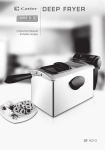

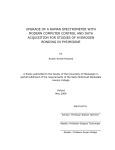
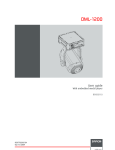
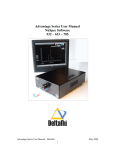
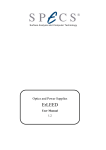

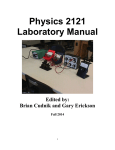
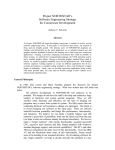
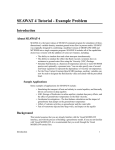
![RessqM, Enhanced Version of RESSQ [Javandel et al., 1984]](http://vs1.manualzilla.com/store/data/005674408_1-e8a4b9f66c80cdc83d847a710e5b4b1f-150x150.png)
